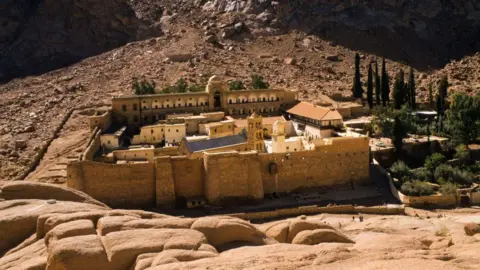For years, visitors would venture up Mount Sinai with a Bedouin guide to watch the sunrise over the pristine, rocky landscape or go on other Bedouin-led hikes.
Now one of Egypt's most sacred places - revered by Jews, Christians, and Muslims - is at the heart of an unholy row over plans to turn it into a new tourism mega-project.
Known locally as Jabal Musa, Mount Sinai is where Moses is said to have been given the Ten Commandments. Many also believe that this is the place where, according to the Bible and the Quran, God spoke to the prophet from the burning bush.
The 6th-century St Catherine's Monastery, run by the Greek Orthodox Church, is also there - and seemingly its monks will stay on now that Egyptian authorities, under Greek pressure, have denied wanting to close it.
However, there is still deep concern about how the long-isolated, desert location - a Unesco World Heritage site comprising the monastery, town, and mountain - is being transformed. Luxury hotels, villas, and shopping bazaars are under construction there.
It is also home to a traditional Bedouin community, the Jebeleya tribe. Already the tribe, known as the Guardians of St Catherine, have had their homes and tourist eco-camps demolished with little or no compensation. They have even been forced to take bodies out of their graves in the local cemetery to make way for a new car park.
While the government is promoting the development as a necessary boost for tourism, critics argue that it is an imposition against the will of the local community. Ben Hoffler, a British travel writer who has worked closely with Sinai tribes, noted, This is not development as the Jebeleya see it or asked for it, but how it looks when imposed top-down to serve the interests of outsiders over those of the local community.
Egypt's government has labeled the ambitious Great Transfiguration Project as Egypt's gift to the entire world and all religions, but local sentiment remains skeptical. Residents fear that they are being edged out of their ancestral lands, exacerbating long-standing grievances between the Bedouin tribes and the authorities.
As new construction continues, including a cable car to Mount Moses and expanded tourist infrastructures, local voices grow more apprehensive regarding the environmental and cultural implications. UNESCO has raised alarms regarding the transformation, urging Egypt to halt developments that threaten the site's integrity, but these recommendations remain largely unheeded amidst persistent construction activity.
The troubled history of the site adds further weight to the ongoing debates. The preservation of Mount Sinai and St. Catherine's Monastery is not just an issue of tourism but one that intertwines faith, culture, and the rights of indigenous peoples.
Now one of Egypt's most sacred places - revered by Jews, Christians, and Muslims - is at the heart of an unholy row over plans to turn it into a new tourism mega-project.
Known locally as Jabal Musa, Mount Sinai is where Moses is said to have been given the Ten Commandments. Many also believe that this is the place where, according to the Bible and the Quran, God spoke to the prophet from the burning bush.
The 6th-century St Catherine's Monastery, run by the Greek Orthodox Church, is also there - and seemingly its monks will stay on now that Egyptian authorities, under Greek pressure, have denied wanting to close it.
However, there is still deep concern about how the long-isolated, desert location - a Unesco World Heritage site comprising the monastery, town, and mountain - is being transformed. Luxury hotels, villas, and shopping bazaars are under construction there.
It is also home to a traditional Bedouin community, the Jebeleya tribe. Already the tribe, known as the Guardians of St Catherine, have had their homes and tourist eco-camps demolished with little or no compensation. They have even been forced to take bodies out of their graves in the local cemetery to make way for a new car park.
While the government is promoting the development as a necessary boost for tourism, critics argue that it is an imposition against the will of the local community. Ben Hoffler, a British travel writer who has worked closely with Sinai tribes, noted, This is not development as the Jebeleya see it or asked for it, but how it looks when imposed top-down to serve the interests of outsiders over those of the local community.
Egypt's government has labeled the ambitious Great Transfiguration Project as Egypt's gift to the entire world and all religions, but local sentiment remains skeptical. Residents fear that they are being edged out of their ancestral lands, exacerbating long-standing grievances between the Bedouin tribes and the authorities.
As new construction continues, including a cable car to Mount Moses and expanded tourist infrastructures, local voices grow more apprehensive regarding the environmental and cultural implications. UNESCO has raised alarms regarding the transformation, urging Egypt to halt developments that threaten the site's integrity, but these recommendations remain largely unheeded amidst persistent construction activity.
The troubled history of the site adds further weight to the ongoing debates. The preservation of Mount Sinai and St. Catherine's Monastery is not just an issue of tourism but one that intertwines faith, culture, and the rights of indigenous peoples.


















